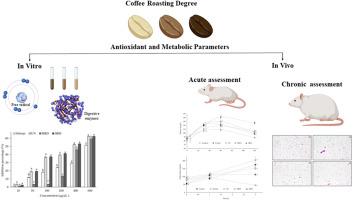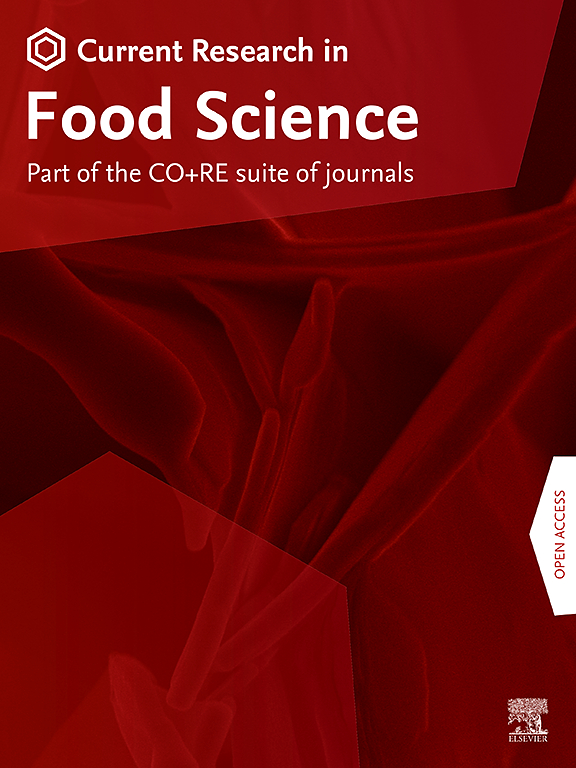Influence of coffee roasting degree on antioxidant and metabolic parameters: Comprehensive in vitro and in vivo analysis
IF 6.2
2区 农林科学
Q1 FOOD SCIENCE & TECHNOLOGY
引用次数: 0
Abstract
This study aimed to assess the impact of roasting degree on antioxidant and metabolic parameters in vitro and in vivo. In vitro, we evaluated radical scavenging, lipid peroxidation, and the activity of digestive enzymes (α-glucosidase, α-amylase, and lipase). In vivo, we first examined coffee's effect on carbohydrate and lipid absorption in healthy rats, followed by a chronic evaluation of metabolic disorders and antioxidant markers using a diet-induced obesity model. In vitro results revealed that increased roasting degree reduced the antioxidant capacity of coffee brews. All brews showed lower inhibition of α-glucosidase and α-amylase, and lipase inhibition compared to the positive control (acarbose or orlistat). In vivo, all roasting degrees consistently reduced postprandial glucose levels by 20%. Notably, coffee with a high roasting degree (HRD) decreased serum triglycerides (TG) by ∼44% after a lipid load, while other roasts did not. Chronic administration of unroasted (UN) or HRD coffee significantly reduced weight gain compared to the obese control (∼15% and ∼10%, respectively). Notably, all coffee samples improved lipid metabolism parameters. UN and HRD coffee significantly decreased adipocyte volume by 58% and 48%, respectively, compared to the obese control. Additionally, all groups exhibited less than 30% hepatic lipid droplets independent of roasting degree. HRD treatment notably increased liver catalase (CAT) activity and reduced lipid peroxidation in serum (∼90%), liver (∼59%), and adipose tissue (∼37%) compared to the obese control group. These findings suggest that HRD in coffee may confer certain biological advantages.

咖啡烘焙度对抗氧化剂和代谢参数的影响:体外和体内综合分析
本研究旨在评估焙烧程度对体外和体内抗氧化剂和代谢参数的影响。在体外,我们评估了自由基清除、脂质过氧化和消化酶(α-葡萄糖苷酶、α-淀粉酶和脂肪酶)的活性。在体内,我们首先研究了咖啡对健康大鼠碳水化合物和脂质吸收的影响,然后利用饮食诱发肥胖模型对代谢紊乱和抗氧化标志物进行了慢性评估。体外实验结果表明,烘焙程度的增加会降低咖啡的抗氧化能力。与阳性对照(阿卡波糖或奥利司他)相比,所有咖啡对α-葡萄糖苷酶、α-淀粉酶和脂肪酶的抑制作用都较低。在体内,所有烘焙度都能将餐后血糖水平降低 20%。值得注意的是,高烘焙度(HRD)的咖啡在脂质负荷后能使血清甘油三酯(TG)降低 44%,而其他烘焙度的咖啡则不能。与肥胖对照组相比,长期饮用未烘焙(UN)或高烘焙度(HRD)咖啡可显著减少体重增加(分别为15%和10%)。值得注意的是,所有咖啡样品都改善了脂质代谢参数。与肥胖对照组相比,UN 和 HRD 咖啡分别使脂肪细胞体积明显减少了 58% 和 48%。此外,无论烘焙程度如何,所有组的肝脏脂滴都少于 30%。与肥胖对照组相比,HRD 处理显著提高了肝脏过氧化氢酶(CAT)活性,降低了血清(∼90%)、肝脏(∼59%)和脂肪组织(∼37%)中的脂质过氧化反应。这些研究结果表明,咖啡中的HRD可能具有某些生物学优势。
本文章由计算机程序翻译,如有差异,请以英文原文为准。
求助全文
约1分钟内获得全文
求助全文
来源期刊

Current Research in Food Science
Agricultural and Biological Sciences-Food Science
CiteScore
7.40
自引率
3.20%
发文量
232
审稿时长
84 days
期刊介绍:
Current Research in Food Science is an international peer-reviewed journal dedicated to advancing the breadth of knowledge in the field of food science. It serves as a platform for publishing original research articles and short communications that encompass a wide array of topics, including food chemistry, physics, microbiology, nutrition, nutraceuticals, process and package engineering, materials science, food sustainability, and food security. By covering these diverse areas, the journal aims to provide a comprehensive source of the latest scientific findings and technological advancements that are shaping the future of the food industry. The journal's scope is designed to address the multidisciplinary nature of food science, reflecting its commitment to promoting innovation and ensuring the safety and quality of the food supply.
 求助内容:
求助内容: 应助结果提醒方式:
应助结果提醒方式:


